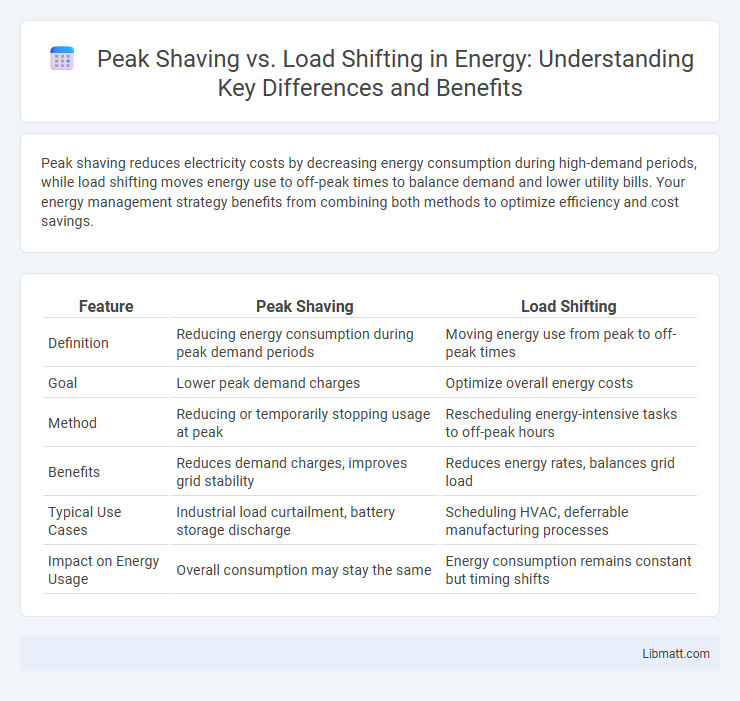Peak shaving reduces electricity costs by decreasing energy consumption during high-demand periods, while load shifting moves energy use to off-peak times to balance demand and lower utility bills. Your energy management strategy benefits from combining both methods to optimize efficiency and cost savings.
Table of Comparison
| Feature | Peak Shaving | Load Shifting |
|---|---|---|
| Definition | Reducing energy consumption during peak demand periods | Moving energy use from peak to off-peak times |
| Goal | Lower peak demand charges | Optimize overall energy costs |
| Method | Reducing or temporarily stopping usage at peak | Rescheduling energy-intensive tasks to off-peak hours |
| Benefits | Reduces demand charges, improves grid stability | Reduces energy rates, balances grid load |
| Typical Use Cases | Industrial load curtailment, battery storage discharge | Scheduling HVAC, deferrable manufacturing processes |
| Impact on Energy Usage | Overall consumption may stay the same | Energy consumption remains constant but timing shifts |
Introduction to Peak Shaving and Load Shifting
Peak shaving involves reducing electricity consumption during peak demand periods to lower energy costs and prevent grid overloads by using on-site energy storage or demand response strategies. Load shifting redistributes energy usage from peak to off-peak hours, leveraging time-of-use pricing and smart grid technologies to optimize energy consumption patterns. Both methods enhance grid stability and cost efficiency by managing demand more effectively.
Understanding Peak Shaving: Definition and Benefits
Peak shaving refers to the strategic reduction of electricity consumption during periods of highest demand to lower peak power usage and minimize energy costs. This approach helps prevent grid overload, reduces the need for expensive peak power plants, and enables businesses to benefit from lower utility rates. Implementing peak shaving improves energy efficiency and supports grid stability by smoothing demand fluctuations.
Load Shifting Explained: Purpose and Mechanisms
Load shifting involves moving energy consumption from peak demand periods to off-peak times to reduce strain on the electrical grid and lower energy costs. This strategy utilizes demand response technologies and energy storage systems to balance supply and demand efficiently. By rescheduling non-critical loads, industries and utilities optimize resource use and enhance grid stability while minimizing reliance on expensive peak power generation.
Key Differences Between Peak Shaving and Load Shifting
Peak shaving reduces energy consumption during high-demand periods by using stored energy or alternative sources to lower peak demand charges, while load shifting moves energy use from peak to off-peak times to take advantage of lower rates. Peak shaving targets reducing demand charges on utility bills, whereas load shifting primarily optimizes overall energy costs by rescheduling consumption. Both strategies enhance grid stability but differ in approach, with peak shaving focusing on immediate peak reduction and load shifting emphasizing temporal redistribution of energy use.
Applications in Commercial and Industrial Sectors
Peak shaving and load shifting are essential energy management strategies in commercial and industrial sectors to reduce electricity costs and enhance grid stability. Peak shaving minimizes demand charges by lowering power usage during peak periods through on-site generation or energy storage, while load shifting redistributes energy consumption to off-peak hours, optimizing operational efficiency. Both techniques support demand response programs and enable businesses to comply with energy regulations and sustainability goals.
Role of Energy Storage in Peak Shaving and Load Shifting
Energy storage systems play a crucial role in peak shaving by storing excess energy during low-demand periods and discharging it during peak demand to reduce the load on the grid. In load shifting, energy storage enables the transfer of energy consumption from high-demand times to off-peak hours, optimizing overall energy usage and lowering costs. Advanced battery technologies like lithium-ion and flow batteries enhance the efficiency and responsiveness of both peak shaving and load shifting strategies.
Impact on Utility Costs and Grid Reliability
Peak shaving reduces utility costs by lowering demand charges during high consumption periods, directly minimizing expenses for large energy users. Load shifting reallocates energy usage to off-peak times, smoothing demand curves and enhancing grid reliability by preventing overloads and reducing strain on transmission infrastructure. Both strategies contribute to cost efficiency and grid stability, but peak shaving targets immediate cost reduction while load shifting supports sustained operational balance.
Integration with Renewable Energy Resources
Peak shaving and load shifting both enhance integration with renewable energy by managing energy demand to match variable renewable supply. Peak shaving reduces demand during high-demand periods, preventing grid overload when renewable output is low, while load shifting moves energy use to times of abundant renewable generation, maximizing utilization of solar and wind resources. Efficient integration supports grid stability and increases the share of clean energy in power systems.
Challenges and Considerations for Implementation
Peak shaving and load shifting both aim to optimize energy consumption but pose distinct challenges such as the need for accurate demand forecasting and advanced control systems. Implementing peak shaving requires managing rapid energy discharge from storage systems, which can strain battery life and increase operational costs. Your energy management strategy should consider these limitations alongside regulatory constraints, equipment compatibility, and potential impacts on system reliability to ensure effective deployment.
Future Trends in Energy Management Strategies
Future trends in energy management strategies emphasize integrating AI-driven analytics and real-time data processing to optimize peak shaving and load shifting. Advances in smart grid technology enable more precise prediction of demand patterns, enhancing load shifting efficiency while reducing reliance on costly peak energy usage. Your energy system can benefit from these innovations by minimizing operational costs and improving renewable energy integration.
Peak Shaving vs Load Shifting Infographic

 libmatt.com
libmatt.com